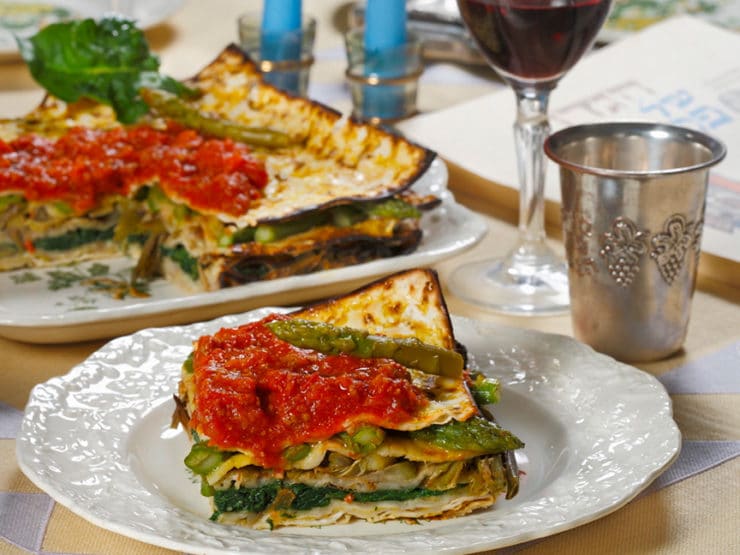
The Passover Potluck is a unique annual online event. I’ve invited my friends, both Jewish and non-Jewish, to share recipes that are kosher for Passover. My goals are simple– to foster mutual understanding between different cultures, to introduce you to my foodie friends, and to share yummy recipes and cooking ideas for Passover! To learn more about the Passover holiday, click here. To learn about what makes a recipe kosher for Passover, click here. To check out the other Passover Potluck recipes, click here.
—
I’m thrilled to introduce you to Alessandra at Dinner in Venice – Kosher Italian Food. Ale is inspired by the flavors of Italy, her home country, and the regional kosher cuisine of Venice. Alessandra is a wonderful cook; her recipes are rustic and authentic. I love this particular dish because it can serve as a healthy and hearty entree at the Seder. While the recipe calls for meat juice and broth, you can easily make this into a vegan side dish using the modifications Alessandra suggests. Enjoy! ~ Tori
—
Alessandra says:
When Tori invited me to participate in her #PassoverPotluck 2012, I immediately knew that I wanted to post an adaptation of a classic Jewish Venetian Passover recipe. On my website Dinner in Venice – Kosher Italian Food, my focus is on Italian food in general (adapted to the kosher rules). However, my true love remains “Cucina Ebraica,” Jewish Italian cuisine – in particular, the traditional dishes from Venice, my hometown. (For some history, pictures, and to find an excuse for a visit, check out the official website of the Jewish Community of Venice).
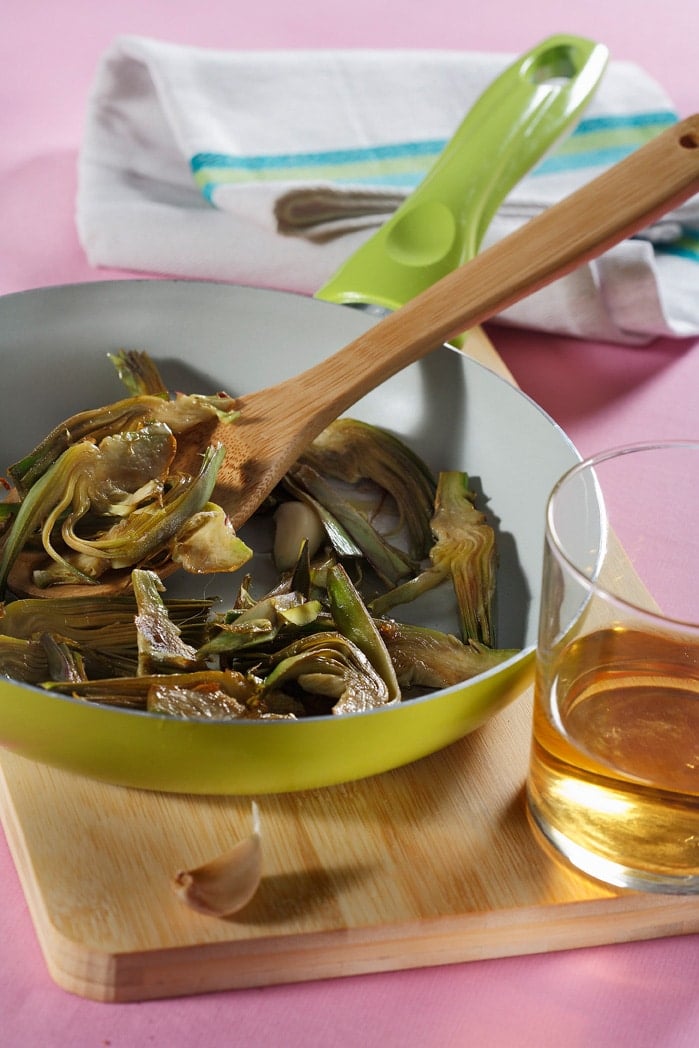
Preparing classic holiday dishes is a way of celebrating some of the contributions that women (mostly women!) throughout the centuries, throughout the world, have made to their communities with their talent and passion. It’s no coincidence that these traditional recipes are often treated with the same respect as the local minhag (religious customs).
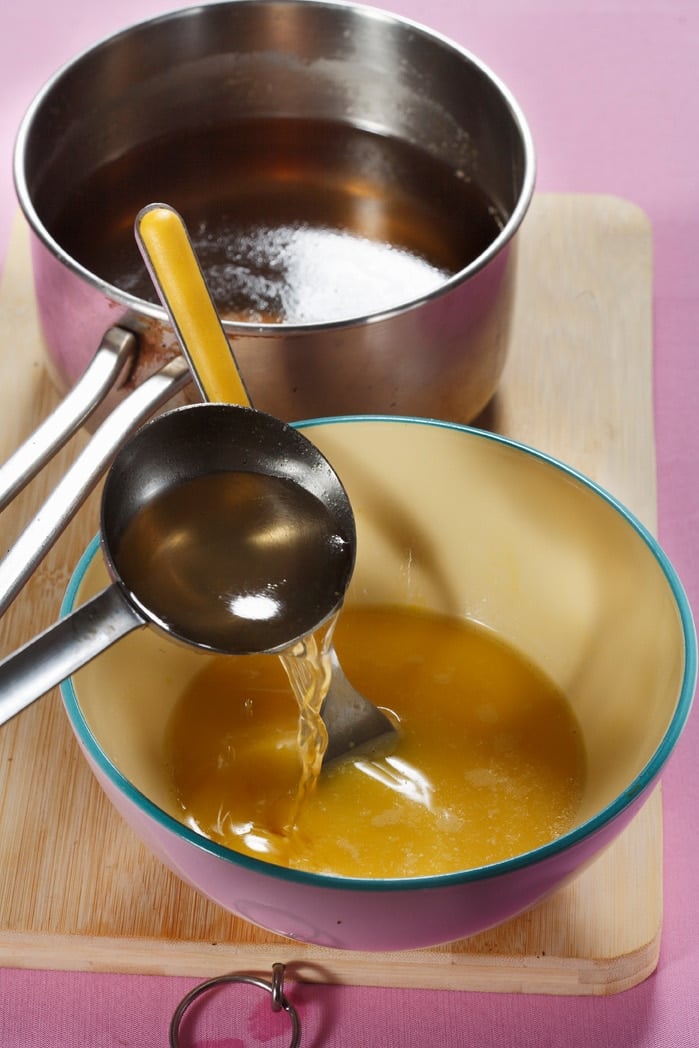
This Vegetable Matzo Pie was an obvious choice for many reasons: first of all, the way it’s arranged reminds me of one of my favorite pasta dishes, vegetable lasagna! You can serve it as an appetizer/first course, Italian-style, or as a side like a kugel. It’s highly customizable: for example, I like to add juice from a meat roast and even pieces of home-made sausage; however, it works just as well as a vegan dish if you skip both the meat juice/meat broth and the eggs.

Another variable is texture: instead of keeping the matzahs whole, you can soak them until they are soft, break them down with your hands, and squeeze the liquid out for a less “al dente” result (but your pie will be less photogenic). You can also substitute different vegetables: as a matter of fact, variations of this dish are found in several Italian communities, each using local vegetables and with minor changes in the other ingredients. Of course, even within the same community, every Jewish mamma has her own recipe, and every son swears that his mom’s is the best…
Buon Appetito!
Recommended Products:
We are a participant in the Amazon Services LLC Associates Program, an affiliate advertising program designed to provide a means for us to earn fees by linking to Amazon.com and affiliated sites. As an Amazon Associate I earn from qualifying purchases.
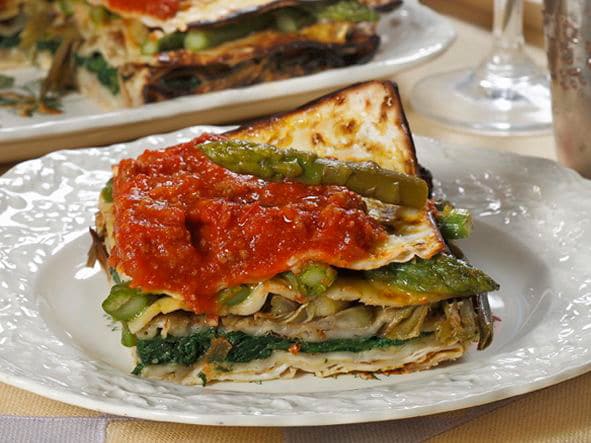
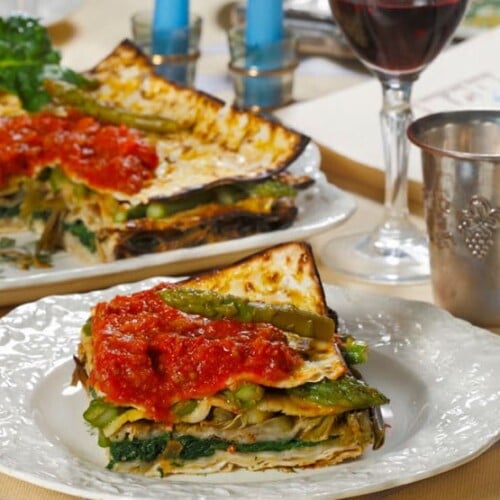
Tortino d'Azzima (Matzo Pie)
Ingredients
Matzo Pie Ingredients
- Extra virgin olive oil (to taste)
- 20 ounces matzo (more or less) (2 boxes)
- 2 pounds cleaned Swiss chard or baby spinach
- 2 pounds artichoke hearts (frozen is ok)
- 2 pounds asparagus or mushroom, cleaned and sliced
- 1 cup dry white wine
- 6 garlic cloves
- 2 quarts cold chicken broth (for soaking the matzo- sub vegetable broth for vegan mod.)
- 3 large eggs (optional)
- Salt and pepper to taste
Sugo d'Arrosto (Roast Juice) Ingredients
- Extra virgin olive oil
- Garlic Cloves
- Rosemary
- 4 ounces ground meat (optional)
- 1 piece marrow bone (optional)
- Salt and pepper to taste
NOTES
Instructions
- Vegetarian/Vegan Modifications: To make this recipe vegan/pareve, omit the eggs, use vegetable broth instead of chicken broth, and make the roast juice without meat (method appears at the end of this recipe).
To make Matzo Pie
- Preheat your oven to 350 degrees F.
- Clean the vegetables, discarding the tougher parts of the artichokes and asparagus. Cut the asparagus into small pieces, slice the artichokes very thinly (if using frozen, partially defrost first), and chop the spinach.
- Blanch the spinach for about 5 minutes in a covered pot with a few tablespoons of water (you can also do this in a covered platter in your microwave). Allow to cool down, then drain and squeeze the liquid out by pressing it into a colander in your sink.
- Prepare three separate skillets on your stovetop, with at least 2 tablespoons of oil in each. Heat the oil and add 2 whole cloves of garlic to each skillet. Place the artichokes in one skillet, the asparagus or mushrooms in another, and the spinach in another.
- Add 1/2 cup of white wine each to the artichokes and the asparagus/mushroom skillets and salt to taste. Turn heat on those two skillets to medium. Allow the vegetables to simmer in the wine till it evaporates.
- Add 1/3 cup of water to the artichokes, and cover both the artichokes and the asparagus. Turn heat to low.
- Salt the spinach skillet to taste (do not add any wine). Turn heat to low.
- Cook all 3 vegetables separately on low heat until very moist and tender, adding some water if they start sticking to the skillet, or if they dry out. Cooking times may vary between 15 and 20 minutes.
- Discard the garlic cloves and set the three vegetables aside. If they feel too dry, add a few tablespoons of broth.
- Make sure you have some “sugo d’arrosto”* (roast juice) ready, or make some following my instructions at the bottom of this recipe.
- Soak the matzahs in cold chicken broth. For a prettier result, soak them briefly (about 10 minutes), a few at a time, not allowing them to crumble (if you soak them for a short time, they might still split in 2, but they will be easy to “re-compose” in the pan). For a softer, kugel-like texture, soak the matzahs for at least 40 minutes until very soft, break them down with your hands into a “mush” and then squeeze the liquid out (some people prefer this texture and they don’t mind the fact that it looks less “pretty”).
- Line the bottom of a baking pan with about ¼ of the soaked matzah. splitting some in ½ or 1/3 as needed to completely fill the perimeter.
- Brush or drizzle with a little “sugo di arrosto” and with about 1/3 cup broth (if you mush the matzah you will need to use less broth; whole matzahs, more broth), and then layer most of the spinach (reserve about ¼ for the top); follow with a layer of matzah, a little more “sugo d’arrosto” and broth, and the artichokes (set aside ¼ of all the vegetables) ; again matzah, roast juice, broth, and the asparagus. You can just top with the asparagus or make a final layer of matzah and top with roast juice.
- Break the eggs and whisk them with 1 cup leftover broth. Pour the mix over the pie slowly, trying to cover it evenly and allowing it to penetrate down the sides (if you are serving this dish as a side and prefer a lighter version, or if you are making a vegan modification, you can skip the eggs).
- Bake for about 40-45 minutes. Half-way through the baking, check the pie, and if it feels too dry, add some more broth, concentrating it on the perimeter of the matzahs. You can also cover it with foil for the second half of the baking.
To make Sugo d'Arrosto (Roast Juice)
- Roast some beef with olive oil, garlic and rosemary leaves. When the meat is done, remove it and strain the pot juices, which you will add to the matzah pie (if it’s not Passover, the roast juices also make an awesome pasta sauce!). If you don’t need to make a whole roast beef, you can make a “fake” roast juice sauce by heating some olive oil in a skillet, and cooking a small amount of ground meat in it with a few whole cloves of garlic, some rosemary, salt and pepper. And if you are vegetarian or vegan, just heat the oil with garlic and rosemary and skip the meat!
Nutrition

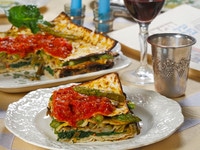


I made the vegan version of this for our second night seder, as we had a vegan and 3 vegetarians coming. It was definitely a hit and I will be making it again… the egg version! My recommendation would be to really read through the instructions before starting as there are some steps within the steps. I was glad to have the opportunity to make and serve something so unique this year.
Hi Tori, I am making the vegan version of this for the 2nd seder. I bought canned artichoke hearts. Is that OK. I’ve never cooked with artichoke hearts before. Thank you!
I would like to make the vegetarian version of this recipe for my seder. Indeed, I am trying substitutions to make it vegan. But my question is: can I prepare it ahead of time and freeze it? Perhaps by cooking it only partway?
Hi Hillary– this recipe is from blogger Alessandra Rovati, I will try to reach out to her. In my experience, matzo mina-style pies like this one typically do not freeze very well.
Hi again Hillary – Alessandra says that yes, you can freeze this recipe. I hope it is helpful!
what do you do with the veggies reserved or set aside. The recipe never addresses that.
(reserve about ¼ for the top)
(set aside ¼ of all the vegetables)
What did you top yours with? It looks like tomato sauce.
Also for the vegan version of the Roast Juice:
how much olive oil, garlic, and rosemary?
Could you just use beef broth instead (non vegan version) for the Roast juice?
Thank you!
I am a good cook, I love your diffrent recipes, I need some new ideas for low salt, no carb or sugar…thanks
I look forward to tasting the vegan version of it !!
This looks absolutely delicious. I love veggie lasagna (all lasagna really) and had never thought of using matzo. So clever and truly it looks so flavorful and savory.
Hi
I made the matzo lasagna last year and it came out great
This looks absolutely mouthwatering – and SO beautiful!
I will try this idea! Just with meat! Wow!
I noticed the red sauce (which looks delicious), is not mentioned in the recipe. When do you add that? During the last part of cooking or at the very end? Thanks!
Hi Rachel, the tomato sauce is not necessary, but when I serve this dish as an appetizer (as an Italian “first course”) rather than as a side, I like to pass around a bowl of home-made tomato sauce or “ragu” (“Bolognaise”). I personally don’t add either to mine, but I liked the pop of color in the picture :-D.
Here are my tips on how to make tomato sauce: http://www.dinnerinvenice.com/how-to.html#8
Gorgeous. Love all the greens and the garlic. A refreshing addition to the Passover table!
This is a beautiful dish! And it looks amazingly delicious!
Brava! Such a super-creative dish! I look forward
to giving this recipe a whirl! Gorgeous dish. Happy Passover!
LL
I would omit the meat & try it with vegetable broth & add ricotta & mozzarella and some parmesean cheese.
Hi Jackie, this has meat in it because we usually serve it at the second Passover seder, before a meat course. If you would like to make it dairy, I think it works better with only one type of vegetable rather than three (I would go with either artichokes or asparagus). You can go with ricotta and mozzarella, but it’s even more delicate if you make a béchamel sauce (using potato starch instead of flour if you are making it for Passover). Of course for the dairy option you can soak the matzo in milk rather than broth. Thanks for your comment! Alessandra
This is genius. Love it!